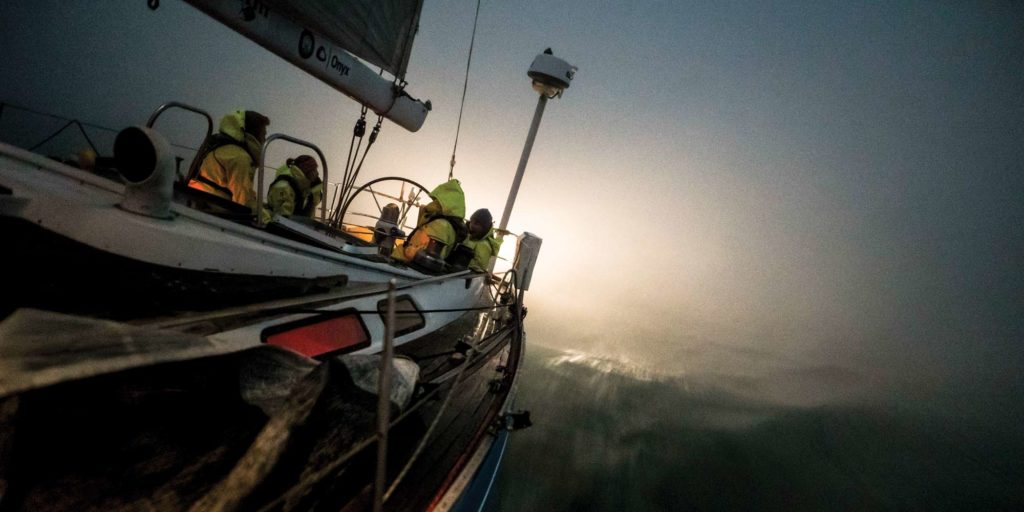
You know those beautifully quiet, majestically serene offshore moments? Well they don’t happen here.”
What Taylor Walker is referring to is the constant drum of conversation among the crew of Dreamcatcher, a 1972 Swan 48 currently being sailed by the young MudRatz Racing Team.
Several hours earlier, we are tied to a dock in Stamford, Connecticut, preparing for an overnight practice on Long Island Sound. Two weeks remain until the start of the 51st Newport to Bermuda Race, and with only a handful of practice nights on board, tonight’s objectives are clear: gain experience sailing in the dark, test new instruments and deliver the boat 70 miles to Mystic, Connecticut, where a morning rig-tune session and evening fundraiser await.
MudRatz was born in spring 2014 from interest in creating a junior sailing “superteam.” With advanced coaching and increased resources, these regional teams can fast-track the learning process for the more competitive-minded. MudRatz founder Brandon Flack didn’t want to cannibalize local yacht clubs and their summer programs, so the initiative began life limited to the wing seasons. The boat donations started with a Melges 24, but the fleet of toys at MudRatz’s disposal has since grown, as has its racing calendar. It now looks after a Melges 20, a 49er, three Melges 24s, a Melges 32 and, most recently, a Swan 48.
It’s April 2018, and Dreamcatcher sits high in its cradle in Jamestown, Rhode Island. “Welcome to the new team clubhouse!” yells Flack from the elevated deck to a confused 20-year-old Sarah Wilkinson, standing alongside the keel below. For a team without a physical address, there is some truth to the statement. “Brandon, what have you done?” she replies.
Sarah’s father, Don “Donzo” Wilkinson, tragically passed away while sailing in 2010. As the founding commodore of the Mystic River Mudhead Sailing Association, Don was passionate about bringing people together over a common love for sailing, and in his honor, the Wilkinsons created the Donzo Wilkinson Award, recognizing such qualities in others. The award was eventually given to Flack for his work with the MudRatz, and upon hearing of its presentation, H.L. Devore — a good friend of Don’s — called Flack the next morning to tell him that Donzo would have wanted the kids to race to Bermuda. That planted the seed, which led the group to Stephen Kylander, who was adamant that Dreamcatcher, his boat of many years, find a worthy new home. The storied racer was soon gifted to Sarah and the rest of the team now assembled in Stamford.
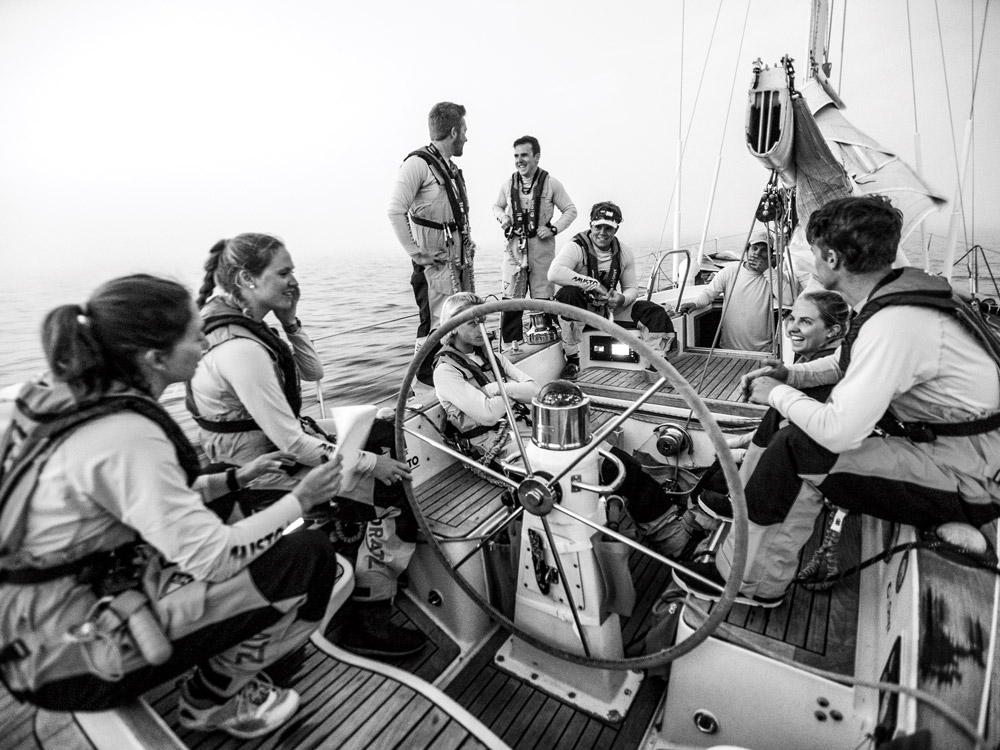
Sarah is one of 11 sailors preparing for the 635-mile voyage to Bermuda. There’s also 17-year-old Peter Cronin, diagnosed with a degenerative hip disease that barred him from contact sports. He took up sailing at age 12, and he brings a fiery desire to win. Fifteen-year-old Gannon Troutman, of Virginia, the youngest sailor on board, saw an ad for sailing and thought it’d be fun.
“I don’t really have an answer as to how I found this,” he claims, vaguely recalling a toy boat he once owned.
Troutman’s parents offered to put him through an introductory course, and he fell for the sport immediately. “I feel free when I’m on boats,” he says. “Especially offshore.”
Troutman now helms the family’s first boat, a J/70, but he ultimately aspires to sail professionally.
This is a collection of young dinghy sailors desperate to grow into bigger boats. They are universally curious.
The remainder of Dreamcatcher‘s cast of young characters includes goofball Fitz Finkenauer, 22, a first-year engineer at General Dynamics, and Anne Longo, 20, who is prone to seasickness but vows to fight through. She’s given up sailing on Wednesday nights so she can fundraise while babysitting for other racers. Watch captain and recent Stanford graduate Lindsay Gimple, 22, is also an engineer at General Dynamics, and is joined by her younger sister Megan, an 18-year-old go-getter and comedian who’s missing this practice to be at prom. There’s the unflappable Morgan Buffum, 23, a gentle giant who never complains. Dreamcatcher boat captain and coach Neal O’Connell, 24, grew up sailing against Walker, and similarly possesses an enthusiasm for teaching kids how to sail. The adults, John Winder and Kylander, are on board as coaches, alongside Walker.
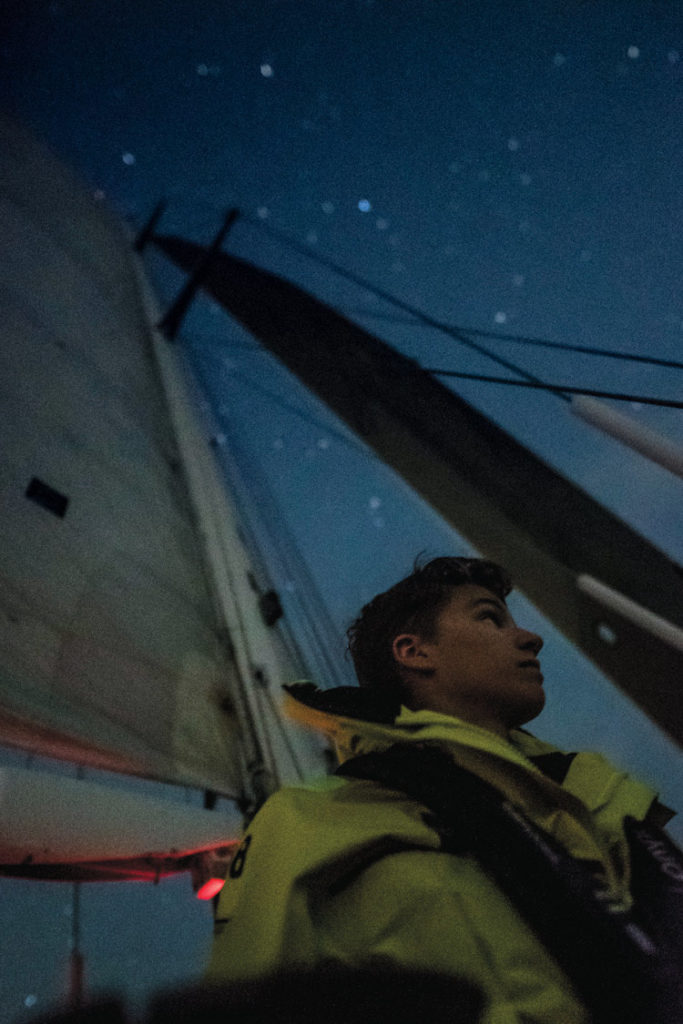
Whenever I try to reach Walker, he’s busy with something team related. He’s installing equipment, fundraising with parents or helping kids through personal issues. Even his fiancee is in on the effort, cooking and preparing the onboard food. At 29, he’s approachable and largely in tune with the kids, yet mature enough to create an environment of respect and discipline. What Walker says largely sticks, and that’s impressive as a young leader of youth sailors.
Walker oversees a small network of volunteers, but the kids must also fundraise themselves. When I arrive in Stamford, a few of them are writing thank-you notes in the cockpit. But tonight’s gathering is not about fundraising, it’s about practice, and as the team parents say their goodbyes, Walker tells me he’s just handed out the new wet-weather gear. “I didn’t want them to have it for the Block Island Race because I wanted them to know how lucky they are to be getting it,” he says. “We were so cold, but they know this is an enormous privilege.”
After a brief pre-departure checklist, we shove off into a windless, foggy twilight. Visibility is extremely limited, and once outside the narrow channel, Walker hands responsibility over to Cronin and Gimple, acting watch captains for the trip. Gimple runs a short but detailed safety briefing that covers emergency equipment on board and the planned watch rotation, then Cronin directs the group to get the sails hoisted.
There’s a lot of indecision as the mainsail starts to go aloft. Crew movement is rough and uncoordinated, and nobody seems too sure of what is happening next or what needs to be done. Slowly, though, all of the right pieces go into place and we edge out into Long Island Sound under main and jib in 3 knots of wind. The engine is turned off, but the boat is no quieter — the banter is accentuated by the stillness of the air. While everyone is settling in before nightfall, necessities like headlamps and batteries become a point of frustration — who stole whose, who forgot theirs — the little things that remind me these are kids and largely inexperienced in the art of offshore preparation. But that’s why they are here, and nothing is handed to them. They are learning from their own mistakes.
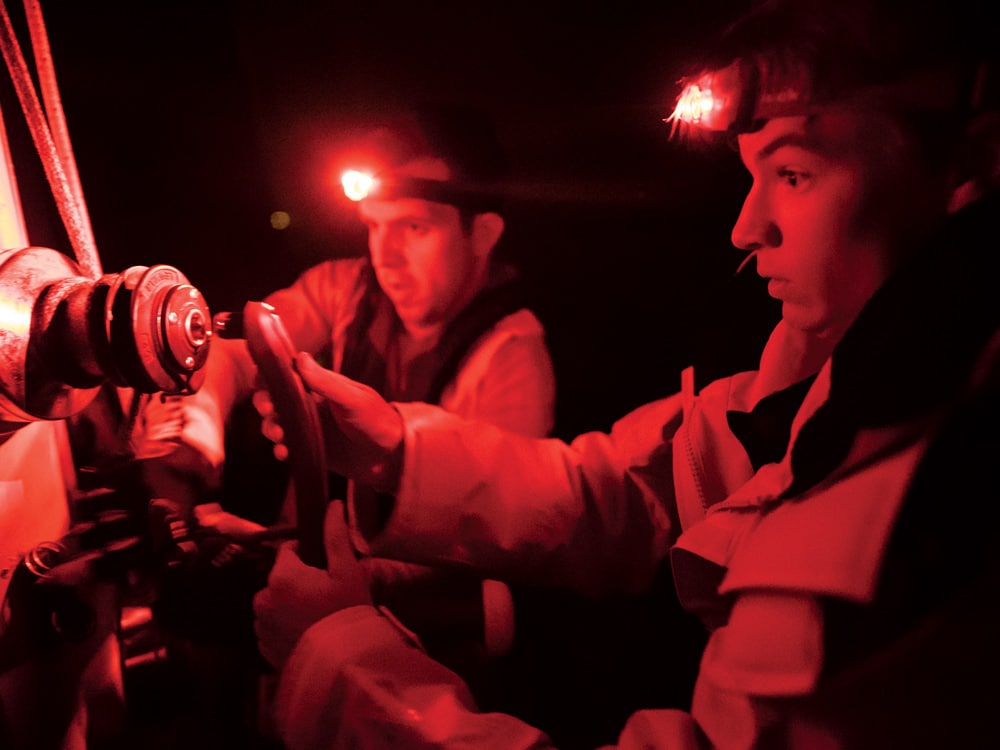
Darkness takes hold, yet still they talk, five of them huddled around the helm like a campfire. The stories are endless, and Cronin has seemingly destroyed a million boat trailers through no fault of his own. A personal favorite involves a blazing tire fire and an unlikely passerby with gallons of water with which to douse it.
The hours roll by. It’s now midnight, and there’s a group in the nav station monitoring the radar. A big thunderstorm is approaching from the west, and they’re apprehensive. Walker has been checking his phone’s weather app, but the lightning is a long way off. Nonetheless, with no wind, concern leads to action and the engine is turned on.
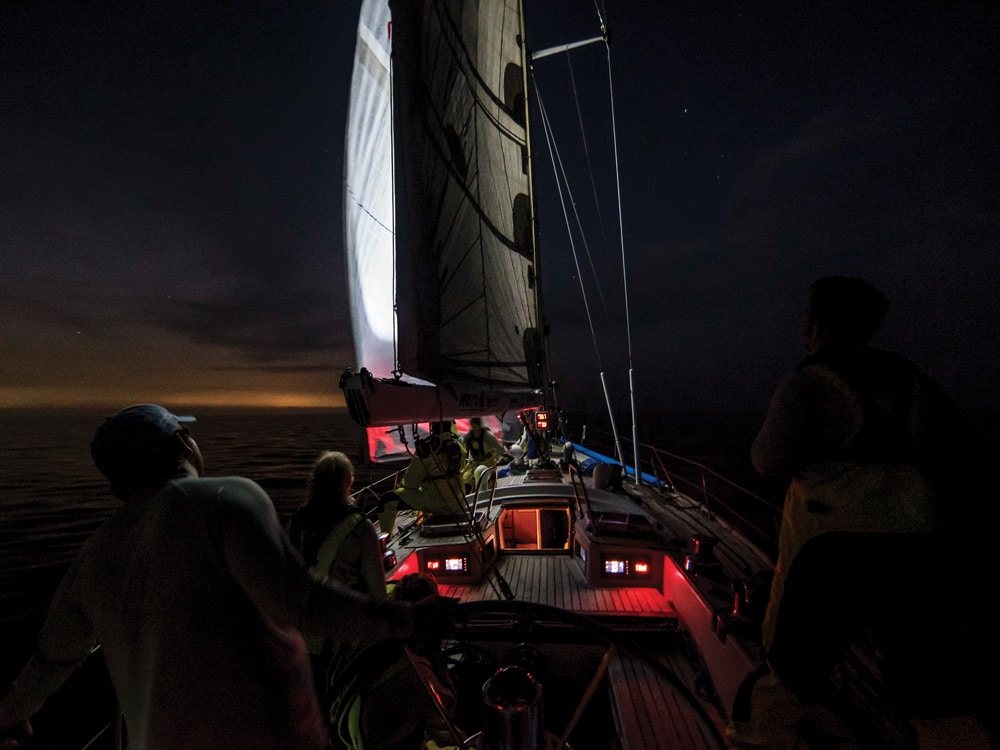
Now under power, the banter resumes, and I start to wonder if it will ever subside. I understand what Walker means when he says serenity doesn’t exist with this group. But I listen intently. This is a collection of young dinghy sailors desperate to grow into bigger boats. They are universally curious about what it takes to make sailing their life, and they are verbally ambitious.
Flack has managed to get a Q&A with Team Brunel as the Volvo Ocean Race fleet races toward Cardiff, Wales, so Walker starts filming questions from the group. Cronin wants to know why Pete Burling is called “Pistol Pete,” and Wilkinson wants to know how Abby Ehler got to be a boat captain in such a male-dominated event. Gimple is making a movie about the MudRatz adventure and has been filming everything, a media crewmember in the making.
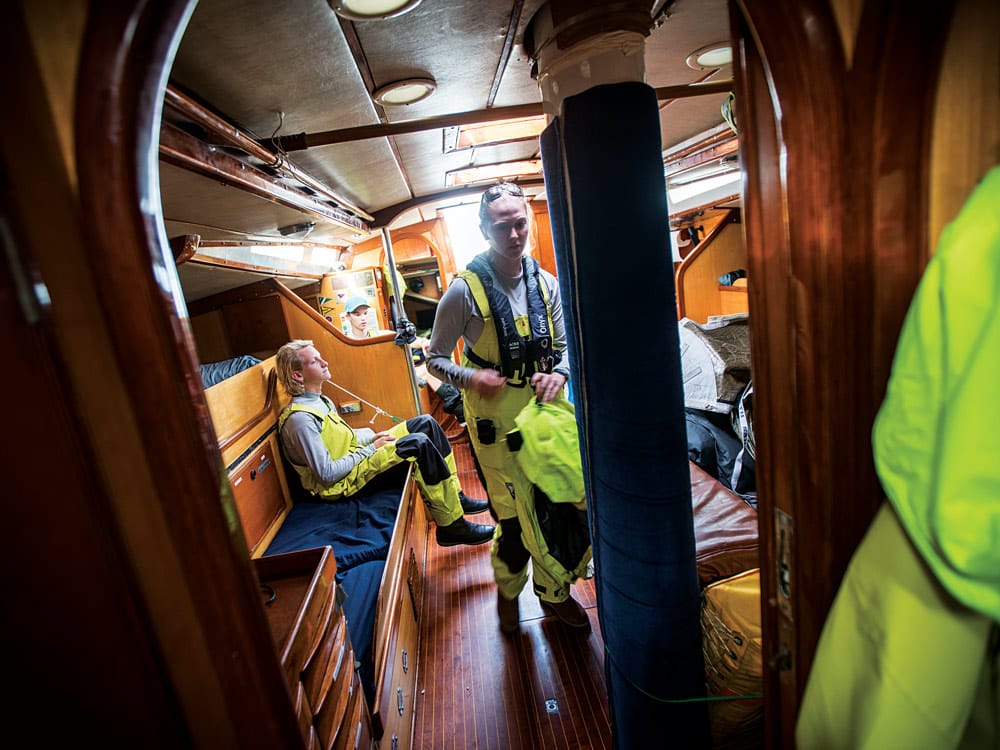
At 0100, the threat of weather behind us is gone, so the engine is switched off. But the fog is thicker than ever. Miraculously, a few kids succumb to sleep. It’s FOMO, the youthful fear of missing out, that has kept most of them awake until now, but fatigue is slowly winning over their will to stay engaged. Wilkinson picks up a faint bow light off the port side. Whoever it was passed very close, but she was watching. The vessel wasn’t on AIS, but there’s also nobody monitoring at the nav station.
There’s a lot of talk about school, pending exams, graduation and summer plans. It’s clear this is a diverse group of kids that span in age and maturity, but their love for sailing supersedes all differences. Their curiosity for one another’s lives is genuine.
I capitalize on the tranquility to pick Walker’s brain and learn more about what makes the MudRatz different from other youth big-boat efforts. He asserts the distinction lies in the amount of preparation and work they do before and after racing.
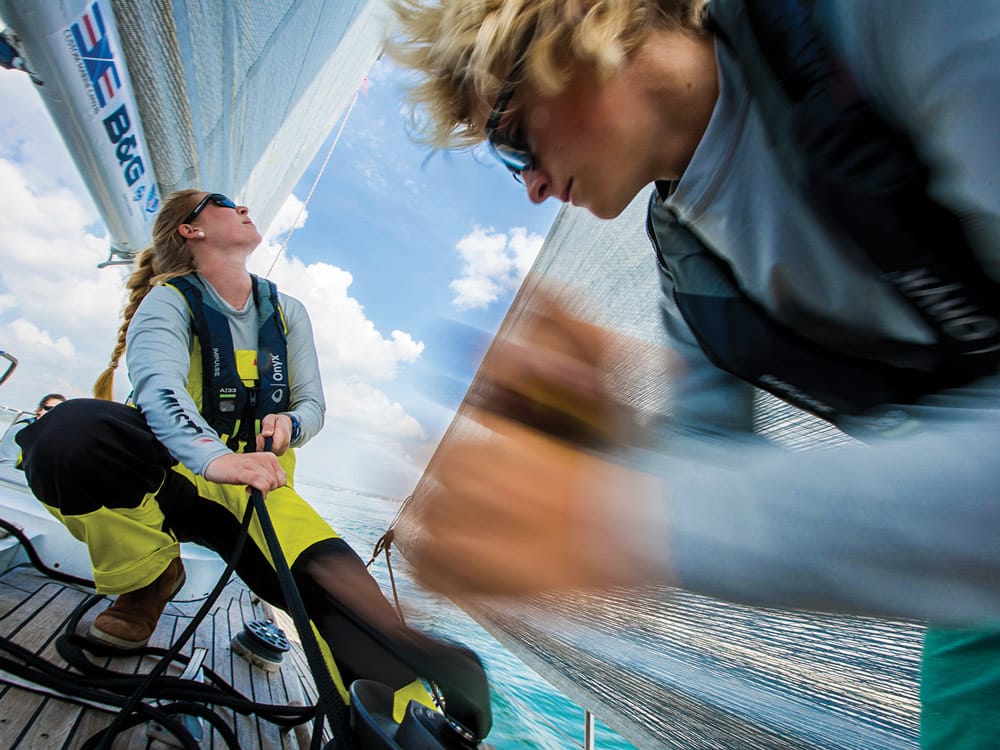
“They are learning the work ethic necessary to survive in competitive sailing. They have no buildings, they have no funding. Group peer pressure to perform and work hard drives them,” he says. “There’s an element of self-selection to it too, where the kids that don’t put in the work don’t survive.”
Flack tries to reward that spirit using his own connections. For example, at the end of the previous MudRatz sailing season, he had the team pick two of their own — the two who worked the hardest — to join the crew of Hanuman during a practice day in Newport before the J Class World Championship. The two MudRatz representatives were so embraced by the Hanuman sailors that they were invited to join the crew dinner that night and come back the next day.
These are kids who aren’t home getting into trouble, wasting their time on their phones or sitting in front of a gaming console.
It’s now 0200, and we’re doing circles in the fog. They’re getting tired and a little disoriented. Things are pretty loose, but it’s important to remember that these are kids who aren’t home getting into trouble, wasting their time on their phones or sitting in front of a gaming console or television. It’s comforting to know that getting lost is still possible in 2018. A while later, I find out the donated radar isn’t working properly. With the heavy fog, inconsistent winds, inoperable radar and an 0900 appointment in Mystic, we again strike the sails and turn to power.
We motor through sunrise, and the boat is finally quiet save for the rumble of the diesel engine. They’ve talked themselves to sleep (or run out of Coca-Cola). I underestimated how significant age can be in terms of sleep and time management, and the effects of this are obvious with this young group.
The Bermuda Race has nonnegotiable “youth team” restrictions, requiring that 50 percent of the crew, plus one, are age 14 to 23, with an average age of 17. The Dreamcatcher crew are 15 to 23, plus Walker, Winder and Kylander, but the ambition for the next Bermuda Race in two years’ time is to have everyone on board under the age of 35.
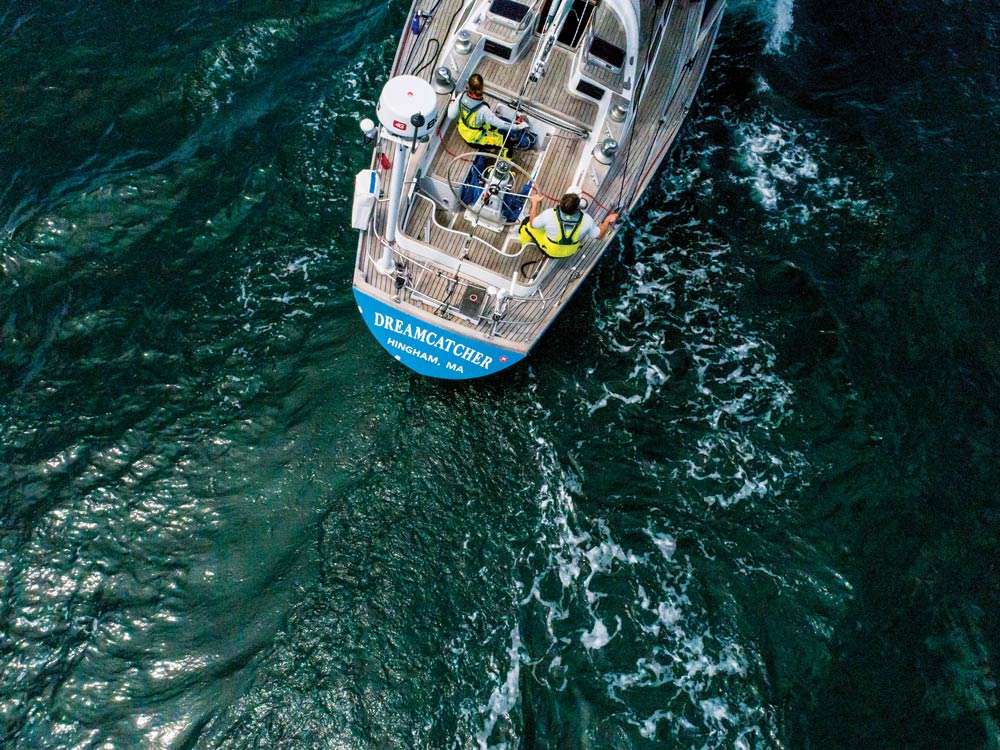
Sailing experience aside, the main obstacle to that becoming a reality is safety. Older people tend to make wiser decisions, and particularly in challenging scenarios like sailing across oceans. But they are learning at that too. Walker instructs safety-at-sea courses for the Storm Trysail Club and has been drilling safe practices throughout the night. As part of its training earlier in the year, the MudRatz team sailed Dreamcatcher to SUNY Maritime in 20 knots to participate in a comprehensive safety course with life rafts and helicopter baskets in a live wave pool (from there, Cronin went straight to prom to hold court as king). Though tonight’s foggy conditions are not favorable for a man-overboard drill, Walker maintains they conduct one every time they go sailing.
Nearing Mystic, Dreamcatcher is still wrapped in heavy fog. I’m downstairs, talking to one of the kids, when through the hatch comes a loud cry. We had nearly run aground on Seaflower Reef, an isolated rocky outcropping surrounded by deep water. Cronin, in the nav station at the time, claims somewhat confidently, “Yeah, yeah, I got it.”
I put my head to the window and there it is, right next to us. A second glance out the companionway shows our wake’s old trajectory running it right over. He clearly did not have it.
Sometime later, when his youthful ego recedes, he offers a sincere apology. “Sorry guys, that was a learning experience. I promise I’ll never make that mistake again.”
Ultimately, this overnight journey is about learning what it takes to compete, but it’s clear that being there for each other and caring for the team is paramount, as is getting firsthand decision-making experience, working hard and taking responsibility for actions. Nowadays, it’s far too rare that kids get such an opportunity. Yet, I also think they know it, and truly appreciate the chance to do Donzo proud.
Two weeks later, Dreamcatcher will finish the Newport Bermuda Race in four days, 14 hours, 23 minutes and seven seconds, winning its 15-boat Class 5 division and placing seventh of 85 overall in the amateur St. David’s Lighthouse Division. The MudRatz are also awarded the Stephens Brothers Youth Prize for the best performance by a youth-division crew.









